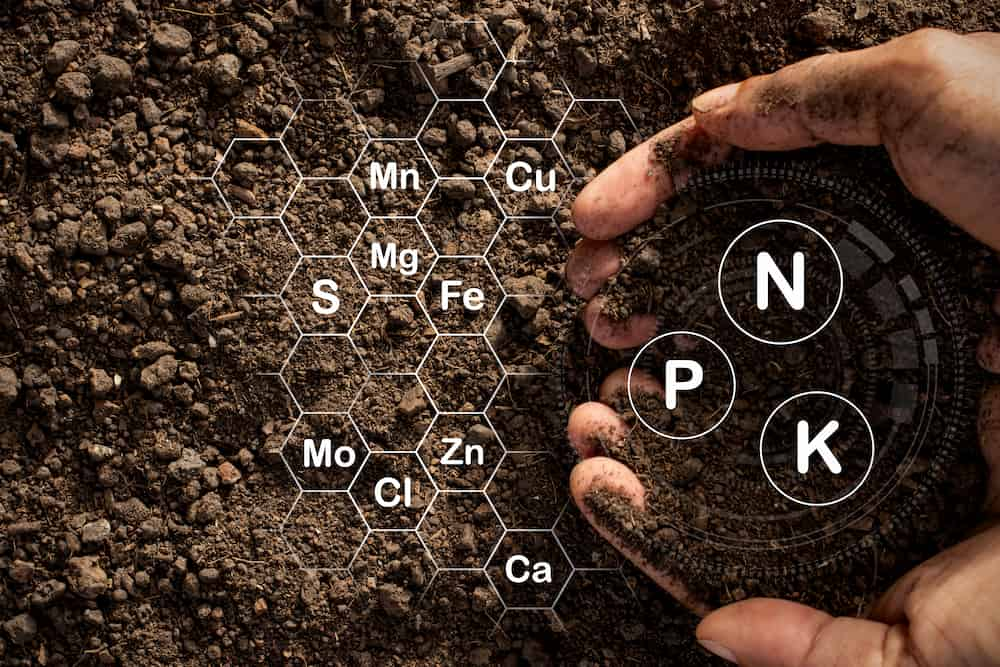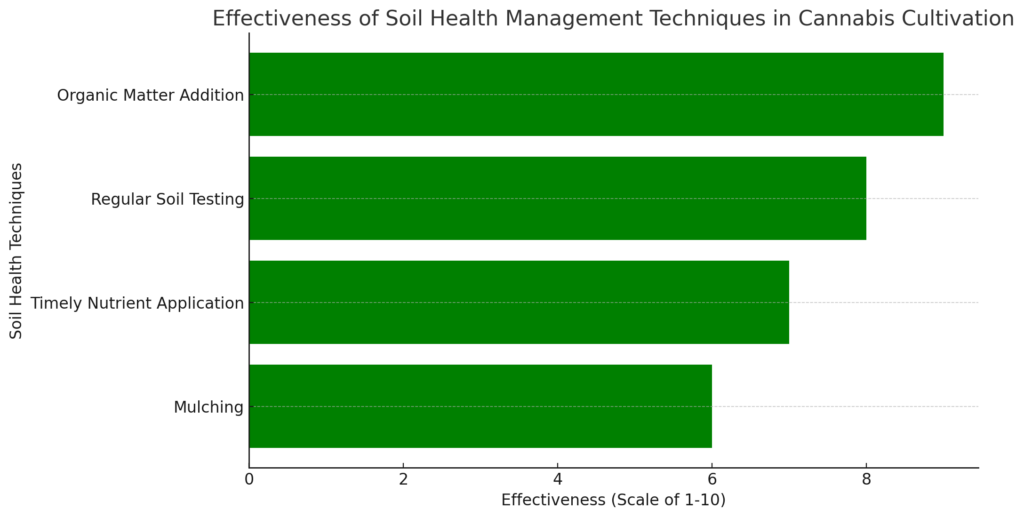Growing healthy cannabis plants starts from the ground up, quite literally. We’ll dive into the crucial role soil health and nutrition play in cultivating robust cannabis plants that yield high-quality buds. It’s not just about watering and waiting; it’s a science that ensures every grow is as fruitful as possible.
The essence of a healthy cannabis plant lies beneath its surface, in the rich, nutrient-filled soil it calls home. Soil health is not merely about the presence of nutrients; it encompasses a dynamic interplay of biological, physical, and chemical properties that create a harmonious environment for cannabis plants to thrive.
Nutrient Essentials: Building Blocks of Cannabis Plant Health
Nutrients are to cannabis plants what a balanced diet is to humans. Essential nutrients like nitrogen (N), phosphorus (P), and potassium (K) – often referred to as NPK – play pivotal roles. Nitrogen is vital for vegetative growth, phosphorus for root and flower development, and potassium for overall health and disease resistance. However, the story doesn’t end with NPK. Micronutrients like calcium, magnesium, and sulfur, alongside trace elements like iron, manganese, and zinc, are equally crucial, albeit in smaller quantities. Here is a graph to demonstrate the importance of the various nutrients.
While it’s easy to get lost in the wide array of soil additives and nutrients available on the market, we always gravitate towards methods that empower the soil’s natural processes. From compost teas to mycorrhizal inoculants, there are plenty of sustainable and effective ways to give your cannabis the best possible start in life.
The Role of Soil pH and Texture in Cannabis Growth
Soil pH, a measure of acidity or alkalinity, significantly influences nutrient availability. Cannabis plants prefer a slightly acidic to neutral pH range, typically between 6.0 and 7.0. This range optimizes nutrient uptake. Soil texture, defined by the size of its particles (sand, silt, clay), affects water retention and aeration. A balance of these components ensures that roots receive adequate oxygen and water without becoming waterlogged or suffocated.
Monitoring and Adjusting Soil Conditions
The health of cannabis plants is directly tied to the health of the soil. Regular testing of soil pH and nutrient levels is essential. Amendments like lime or sulfur can adjust pH, while organic matter can improve texture and nutrient content. The goal is to create a balanced ecosystem where cannabis plants can access the nutrients they need when they need them.
For more insights into the different stages of cannabis growth and their specific light requirements, explore our detailed guide on growing stages and light requirements for cannabis.
Soil Composition for Cannabis Growth
In the pursuit of cultivating robust cannabis plants, it’s crucial to delve into the nitty-gritty of what makes up the soil they grow in.
Role of Mineral Particles (Sand, Silt, Clay)
Soil is not just a mere growing medium; it’s a dynamic habitat that provides foundation and nutrients. The role of mineral particles such as sand, silt, and clay can’t be overstated.
- Sand is gritty and coarse, aiding in drainage and aeration.
- Silt, with its fine quality, holds onto water and nutrients.
- Clay, being the finest of them all, binds to nutrients very effectively but can often lead to water retention issues when not balanced correctly.
The ideal soil for cannabis combines these minerals in a way that maintains structure while offering optimal water retention and airflow. To ensure healthy root development and efficient nutrient uptake, we should aim for a well-proportioned blend, often referred to as loamy soil.
Importance of Organic Matter in Soil
The significance of organic matter in soil health is undeniable. It’s the life force that energizes soils with nutrients, beneficial microorganisms, and essential elements required for vigorous cannabis growth.
Enriching soil with organic matter:
- Improves soil structure and porosity.
- Increases nutrient content.
- Boosts microorganism activity which in turn aids nutrient cycling.
Organic matter, which is composed of decaying plant and animal residue, serves as a buffet for the soil’s microbial life. These tiny workers transform organic material into available nutrients, promoting healthy, productive cannabis plants. By prioritising soil composition and the incorporation of rich organic matter, we pave the way for cannabis plants to thrive and reach their full potential.
Macronutrients: NPK Ratio

Cannabis plants need the right ratios of nitrogen (N), phosphorus (P), and potassium (K) tailored to their specific growth stage for healthy development.
As a general rule, a 3:1:1 NPK ratio works well during the vegetative stage for most strains. This supplies ample nitrogen to stimulate lush foliage growth along with adequate phosphorus for root development and potassium for overall plant vigor.
Once flowering commences, the ratio should transition – reduce nitrogen levels as phosphorus and potassium needs rise. An NPK ratio of 1:3:2 is optimal in early flowering to support bud formation. Towards the end of the flowering stage, a 0:3:3 ratio focuses the plant’s energy exclusively into dense, robust blooms.
Each nutrient serves distinct functions:
- Nitrogen enables vigorous leaf and stem growth
- Phosphorus aids root, flower, and seed production
- Potassium boosts overall health and regulates enzyme functioning
Achieving the precise NPK ratios tailored to the plant’s stage of growth is crucial. Deficiencies or excesses can easily stunt development and diminish yields. By continually adjusting these nutrient levels, we set our plants up for vigorous, bountiful harvests.
Micronutrients: Supporting Plant Health
While macronutrients often steal the spotlight, micronutrients play an equally pivotal role in the health and development of cannabis plants. These include:
- Calcium, which strengthens plant’s cell walls and supports structural development.
- Sulfur, a key player in the creation of vitamins and amino acids.
- Magnesium, essential for chlorophyll production and the metabolization of sunlight.
Achieving the correct balance of micronutrients can often mean the difference between a bumper crop and disappointment. Here’s a tableau of crucial micronutrients and their primary functions to simplify the complexity:
| Nutrient | Function |
|---|---|
| Calcium | Cell wall strength, structural support |
| Sulfur | Vitamin and amino acid formation |
| Magnesium | Chlorophyll production, sunlight metabolization |
Incorporating a thorough understanding of essential nutrients into your soil health strategy is pivotal. By appropriately balancing these nutrients, you ensure your cannabis plants have the support they need to grow up healthy and strong.
Choosing the Right Soil Type
Soil Varieties and Their Impact on Different Cannabis Strains
When it comes to cultivating cannabis, not all soils are created equal. Each strain may prefer a different soil type — some thrive in light, airy soils, while others need denser soil structures to support their roots. For instance, sandy soils offer excellent drainage which is ideal for strains prone to root rot. On the other hand, a strain that’s robust and resilient might be better suited to clay-heavy soils, which provide superior nutrient retention.
It’s essential to match the soil variety to the cannabinoid profile you’re aiming for. Through precise soil selection, we can manipulate conditions to favor the production of either THC or CBD, enhancing the potency and medical efficacy of our plants.
Adapting Soil Choice to Climate and Environment
Your growing climate and environment play pivotal roles in deciding the right soil type for your cannabis plants. In arid regions, using a soil that retains moisture will counter the dry climate, whereas in more humid areas, well-draining soil types like sandy loam prevent over-saturation and root diseases.
Adaptation is key, and we must consider the local environment to ensure our plants flourish. For growers facing extreme temperatures, understanding the impact of heat on cannabis plant health can guide them in choosing a soil with suitable water retention and aeration properties to mitigate stress on the plants.
The Impact of Soil Texture on Root Development
In most cases a light and fluffy soil texture is paramount for cannabis plants, as it allows roots to expand, strengthens the plant, and facilitates better nutrient uptake. Properly textured soil should balance drainage and water retention to prevent waterlogging and ensure oxygen reaches the roots.
In this regard, an ideal mix often contains amendments like perlite or vermiculite to enhance aeration and improve drainage. We also incorporate organic matter, such as compost or worm castings, to boost the soil’s nutrient profile and its water-holding capabilities.
Maintaining the right soil condition is a balancing act that requires attention to detail and a willingness to adapt as plants grow and their needs change. The effort put into optimizing soil pH and texture will be evident in the robust health and vigour of the cannabis plants we nurture. It’s always rewarding to see the direct impact of these factors on the success of our crops, so we make it a priority to manage them carefully and consistently.
Organic vs. Chemical Nutrients
As we delve deeper into the cultivation process, it’s important to recognise the distinction between organic and chemical nutrients, both of which have significant roles in nourishing cannabis plants. Experienced growers often have a preference and we like Organic, but understanding when and why to use each type can be crucial for optimal plant health.
Benefits of Organic Nutrients
Organic nutrients are derived from natural sources such as compost, manure, or bone meal. These nutrients improve the overall structure of the soil, and encourage a web of microbial activities that play a pivotal role in natural nutrient cycling. Here are some key benefits of organic nutrients in cannabis cultivation:
- Enhanced Soil Life: Organic matter is the lifeblood of fertile soil. It provides a habitat for beneficial microorganisms, which in turn make nutrients more accessible to cannabis roots.
- Sustainable Practices: Using organic nutrients supports sustainable growing practices, lessening the environmental impact.
- Improved Plant Resilience: Plants nurtured with organic matter may develop better resistance to pests and diseases.
- Flavour and Quality: Many growers believe that organic nutrients contribute to a superior flavour profile and high-quality cannabis.
For those interested in exploring organic cultivation in Thailand, we have you covered..
When to Use Chemical Nutrients
Chemical nutrients, also known as synthetic nutrients, are man-made versions of essential plant nutrients. They are often concentrated and can be tailored to provide specific nutrient ratios ideal for different growth stages. Here’s when using chemical nutrients might be more advantageous:
- Rapid Growth: Synthetic nutrients can stimulate faster growth as they are readily available to plants.
- Controlled Doses: With chemicals, it’s easier to control the exact nutrient levels, minimizing the risk of deficiencies or toxicities.
- Convenience: Chemical fertilisers are often easier to store and use throughout the growing cycle.
- Cost-Effectiveness: In some cases, synthetic nutrients may be more cost-effective, especially for larger-scale operations.
While the decision to use organic versus chemical nutrients is often a matter of personal preference and cultivation philosophy, we recognise the need for flexibility, depending on the specific conditions and goals of each grow. At SmokingSkunk we believe in Organic and you can read up on PGR here.
Common Problems and Solutions with Soil and Nutrients

Identifying and Addressing Nutrient Deficiencies
Nutrient lockout is a common issue where plants are unable to absorb essential nutrients from the soil due to an imbalance in pH levels or a build-up of salts. This can lead to visible symptoms such as yellowing leaves, stunted growth, and poor bud development. The key is to identify these deficiencies early on by paying close attention to the plant’s overall health and leaf condition.
To address nutrient deficiencies, we need to:
- Check the pH levels of our soil regularly, ensuring they fall within the optimal range for cannabis cultivation, usually between 6.0 and 7.0.
- Flush the soil to remove excess salts by watering plants with pH-balanced water.
- Replenish nutrients by carefully selecting and applying the appropriate fertilizers, keeping in mind the specific needs of the plant during its growth stages.
For those looking to delve deeper into pest and disease management strategies that complement nutrient solutions, we recommend exploring detailed guides on Pest Management in Cannabis Cultivation.
Managing Soil pH and Texture Issues
Managing soil pH and texture is crucial for maintaining a healthy environment for cannabis roots. We understand that soil that’s too acidic or alkaline can block nutrient uptake, while the wrong texture can lead to inadequate aeration and water retention.
We can manage these soil challenges by:
- Adding organic materials like peat, compost, or manure to improve texture and nutrient content.
- Using lime to raise the pH of acidic soils or sulfur to lower the alkalinity in basic soils.
- Implementing regular soil tests to monitor pH levels and amend the soil accordingly.
- Mulching is a straightforward but often overlooked aspect of soil health. By covering the soil surface with organic materials like straw or bark, you can conserve moisture, regulate soil temperature, and suppress weed growth, all of which contribute to a healthier root environment.
It’s important to get the balance right, as the ideal soil texture should provide enough space for air and water to move, but also retain enough moisture and nutrients to feed the roots throughout the plant’s lifecycle. By keeping these tips in mind and monitoring soil conditions frequently, we can significantly improve our cannabis crop’s health and vigor.
We’ve explored the intricate dance between soil health and nutrition that’s vital for thriving cannabis plants. By understanding the balance of mineral particles and the necessity of organic matter, we’re equipped to foster a rich environment where our plants can flourish.
Frequently Asked Questions
What roles do mineral particles like sand, silt, and clay play in soil health for cannabis cultivation?
Mineral particles determine the soil’s drainage, water retention, and nutrient availability which are crucial for healthy cannabis plant growth. Sand improves drainage, silt enhances nutrient retention, and clay holds water well.
How does organic matter contribute to soil health in growing cannabis?
Organic matter boosts soil health by enhancing its structure, increasing nutrient levels, and supporting beneficial microorganism activity, all of which contribute to the optimal growth of cannabis plants.
How do you identify and address nutrient deficiencies in cannabis plants?
Identify nutrient deficiencies by examining plant symptoms like discolouration or stunted growth. Address them by checking soil pH levels, flushing the soil with water, and applying the necessary nutrients.
Why is managing soil pH and texture important for cannabis plants?
A proper soil pH and texture are vital for healthy root development and nutrient uptake. Managing these factors ensures your cannabis plants have the right conditions to grow vigorously.
